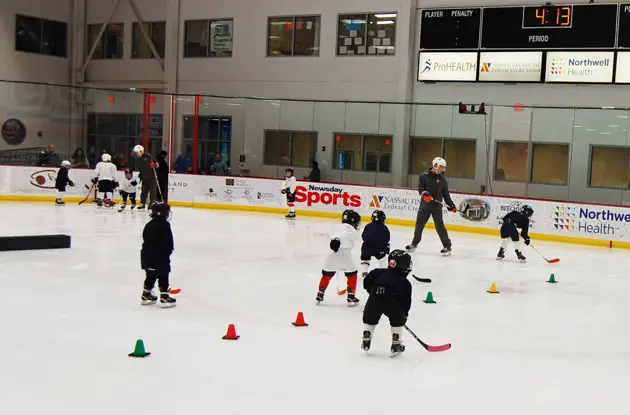To perform well in sporting events and support healthy development, teen athletes need to eat balanced meals that provide key nutrients. A registered dietician gives the play-by-play on what teen athletes should be eating.
Justin is a 6-foot-2-inch, 170-pound high school senior who played basketball competitively from age 8 to his junior year in high school, when he switched to track and field. Justin, who practically burns off calories before he consumes them, placed no limits on his food intake while playing basketball. In a typical day, he would eat two breakfasts, five or six granola bars just to tide him over until lunch, then he would eat two school lunches and, in his free period before the end of the day, walk to the nearby McDonald’s where he’d have a double burger, fries, and a sweet tea. Plus, he’d carry lots of candy in his backpack, which he’d snack on throughout the day—and this was all before practice.
According to the Sports & Fitness Industry Association, 3 out of every 4 teenagers in the U.S. play at least one team sport. And in 2010, based on a study by the National Federation of State High School Associations, more than 7.6 million athletes played organized high school sports—the largest group of participants ever.
Because of all the physical training involved in playing sports, teen athletes need to fuel their bodies with an appropriate balance of carbohydrates, protein, fat, and fluids. It may sound simple, but striking this balance can be a challenge, because adolescence is one of the most significant growth periods in life and teens require specific nutrients to support the physical changes it brings. Yet, during these years, teens start to eat out of the house more often, are more likely to be influenced by what their peers are eating, become more body conscious, and begin to assert their independence, which means they want more control over their food choices.
Eating for Health
According to most recent studies, many teens aren’t getting enough of the vitamins and minerals necessary to support appropriate growth and development. Teens participating in competitive sports face an additional challenge in trying to meet their body’s demands for more calories, nutrients, and fluids. Adolescent athletes need to consume an appropriate diet in order to maintain health, support their growth, and achieve optimal performance. Most teens, however, don’t get enough key nutrients or fiber in their diets and, like Justin, they often consume too much fat, cholesterol, sodium, and sugar.
Some of the culprits that affect athletic performance are low iron levels, which can result in poor stamina, and insufficient magnesium, which may make the athlete prone to cramping during activity. Other important nutrients are vitamin C, which helps promote wound healing, and vitamin B6, which is linked to energy and the production of hemoglobin, a protein that helps red blood cells transport oxygen.
Foods high in sodium, sugar, cholesterol, saturated fats, and trans fats in a typical teen diet on the other hand, not only impede an athlete’s performance, they pose a critical threat to teens’ health by increasing the risk of obesity and developing type 2 diabetes, heart disease, and certain cancers.
When Justin switched to track and field in his junior year, he quickly realized that his diet wasn’t allowing him to compete at his best. As his nutritionist, I worked with him to improve the quality of his diet in a way that would sufficiently fuel him while he strived to improve his athletic performance. He now eats better quality, leaner protein and more of it, consumes more complex carbohydrates such as brown rice and whole-grain pasta, has switched out most of the granola bars and sugary snacks for fresh fruit, and hasn’t eaten McDonald’s in almost a year. Instead, on practice days, he will have a whey protein shake with 2-percent milk, and, in the couple of days before a track meet, will avoid red meat, have more chicken or fish, and eat more vegetables than usual.
Although Justin now eats less, he is consuming better quality foods that provide him with sustained energy. He has been able to maintain his weight and improve his running. He doesn’t get hungry as frequently, and he feels much better.
Teens like Justin may head to practice after school, but fueling up for that exercise starts with a healthy breakfast. Starting the day with a quality breakfast not only curbs hunger, it provides the nourishment needed for rigorous training later in the day. Ideally, breakfast should contain carbohydrates to fuel muscles, protein to help build them, a little fat for added energy, and some vitamins and minerals such as calcium, potassium, vitamin C, and fiber. This can be as simple as whole-grain cereal with low- or non-fat milk (or soy milk) with banana slices and a glass of orange juice; a bagel with peanut butter and a sliced apple; or something heartier, such as two pancakes with a scrambled egg or egg whites, three pieces of turkey or bacon (soy-based, if desired), and melon slices. Your teen should also have a mid-morning snack, as he may get hungry again before lunch. A handful of nuts and raisins or a cheese stick with some crackers should do the trick.
Fueling Teen Athletes
Allison, a 5-foot-5-inch, 120-pound high school sophomore, has been playing volleyball competitively year-round since seventh grade, and she also plays soccer in January and February. Her mother Karen was concerned because Allison “has always been a carb and cheese freak” and, if not for her constant physical activity, would struggle with her weight. As a female athlete, Allison needed a diet that would manage her weight while supporting her level of activity and her body’s needs for growth.
Carbohydrates, protein, and fat provide teens with calories that can be used as fuel for the body, but of these, carbs are the most efficient fuel for the body.
Ideally, a little more than half of an athlete’s total energy should come from carbohydrates. Good sources include high-fiber foods such as oatmeal, brown rice, whole-wheat pasta, bread, cereals, popcorn, pretzels, bananas, apples, oranges, dried fruits, and starchy vegetables such as potatoes and yams.
About 12 to 15 percent of an athlete’s calories should come from protein. Protein builds and repairs muscle, bone, cartilage, skin, and blood, making this nutrient an essential part of the growing adolescent’s diet. Protein is most effective if eaten in moderation and distributed throughout the day as part of the teen’s meals and snacks. Good protein sources include low- or non-fat yogurt (especially Greek yogurt, which has a higher protein content), lean cuts of turkey and chicken, eggs, low-fat cheeses, fish, and soy products. Other foods that contain protein as well as important vitamins and minerals are beans and peas, nuts, seeds, and nut butters. Vegetables also contain some protein.
It is important to note that excessive protein intake will not result in increased muscle mass or improved performance. In fact, too much protein, whether from whole foods or supplements, can be dangerous and put teens at risk for dehydration, put stress on the kidneys, and will essentially be stored as fat, not muscle.
In addition to carbs and protein, about a quarter of a teen’s calories should come from fat. Fat actually provides more energy than protein, making the daily requirement of calories from this nutrient higher. However, most sources should be from the healthier, unsaturated fats such as those in nuts, avocado, olives, flaxseed, salmon, trout, herring, and vegetable oils. Fat contained in low- and full-fat dairy, poultry, and red meat products should make up only a small percentage of a teen’s total fat intake. Because fat is such a significant source of energy, severe restriction is likely to have negative consequences on the athlete’s performance.
The day of a practice or event, young athletes can determine how much to eat based on how much time they have beforehand:
30 minutes-1 hour before: A snack containing 15-30 grams of carbs, with less than 5 percent fat. Good choices would be 1 cup of non-fat or 2-percent yogurt with a small banana or 1 ounce of dried fruit and nut trail mix.
2-4 hours before: A light meal containing 30-40 grams of carbs, with 5 to 15 percent fat. For example, a turkey sandwich with 1 cup of baby carrots or half a whole-wheat bagel with 2 tablespoons of peanut butter and an orange.
4-5 hours before: A large meal containing 50-60 grams of carbs, with 15 to 25 percent fat, and possibly a small snack closer to the practice/event. Examples include 2-3 ounces of baked chicken or fish with half of a large baked potato, 1 cup of broccoli, and an apple; or 2/3 cup of rice (preferably brown) with ½ cup of beans (black, red, pinto, lentils, chick peas, baked, or refried), half of a medium avocado, and a kiwi.
Allison now understands she has to eat well to maximize her energy and performance. Karen makes sure Allison’s day starts with breakfast consisting of a grain, a protein, and some fruit. Typically, Karen will send her to school with a turkey sandwich, a mandarin orange, and a protein bar. On practice days, Karen brings Allison foods such as hard-boiled eggs, bagels, apples, and carrots. After practice, when she’s hungry again, Allison reaches for options such as grapes, trail mix, pretzels, or a low-fat cheese stick. Allison and her mom negotiate, too, so Allison can eat foods she enjoys without feeling deprived, while exercising the most discipline for days leading up to and during competitions. Competitive athletes will always benefit from properly fueling their bodies, but on days leading up to a competition, when performance theoretically counts the most, they have a greater advantage if they’ve diligently stuck to an appropriate diet.
Keep ’em Hydrated
Fluids play a critical role in sustaining the health and peak performance of the teenage athlete. Dehydration can be incredibly dangerous in sports. It is crucial for the teens to be well hydrated before, but they must continue to hydrate during and after exercise in order to optimize their performance.
Water is always an ideal source of fluids. Coconut water is also a good option as it’s loaded with electrolytes and provides a natural alternative to sports drinks that have added sugars and artificial colors and flavoring.
How much water should your teen be drinking?
1-2 hours before activity: 14 to 16 ounces of water (about two cups)
10 to 15 minutes before activity: 10 to 12 ounces (about 1½ cups)
During activity: 6 to 8 ounces (about a cup) every 20 minutes
After activity: 16 to 24 ounces (two to three cups) for every pound of weight lost
Signs of dehydration include dark urine, diminished urine output, lethargy, elevated heart rate, headaches, reduced sweating, muscle cramps, chills, nausea, and even seizures.
Your Role as Parent
What can parents do to ensure their teen athletes maintain a healthy diet? Stay involved. Promote meals and snacks that center around variety, moderation, and balance; have healthier foods available at home and for on the go; provide nutrient-rich snacks and sufficient fluids for practices and competitions; and, as always, be good role models.
It is also important that parents educate their children on all aspects of healthy training for competitive sports, rather than expect the coaches to do it for them. Parents need to be proactive, looking out for signs and symptoms of dehydration, use and abuse of performance-enhancing drugs, unhealthy eating habits, or dramatic changes in their child’s weight.
By helping your teen stick to a healthy diet full of nutrient-rich foods, with an appropriate balance of carbohydrates, protein, fat, and fluids, you’ll give him every advantage to achieve peak performance in his sport.
Nutrition for Younger Athletes
Got a younger child who’s playing sports? See Werner’s advice on proper nutrition for young atheletes.
Robin Werner MS, RD, was, once upon a time, a teenage athlete herself. The daughter of a competitive swimmer and coach, she played Little League and then joined her school’s tennis team from eighth grade until senior year. She and her husband, Greg, live in Westchester with their three children, all of whom have carried on the athletic tradition with their activities of choice: softball, ballet, and golf. For more information, visit wernernutrition.com or “like” the Robin Werner Nutrition page on Facebook.




















